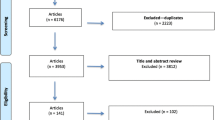Abstract
This paper examines factors that influence whether or not employees choose to enroll in a group long-term care insurance plan. A conceptual family decision-making framework is used to group factors to study the enrollment decision of 509 state employees who were offered a long-term care insurance plan in 2000. Logistic regression results revealed that employee age, perceived risk, perceived affordability, decision-making style (communication with others and use of information), goals of control and choice, goal of financial peace of mind, household income, and potential caregiver availability explained 68.7% of the decision to enroll. Results support the key role of perception, specifically the perceived risk of needing long-term care and the affordability of the insurance plan, in the decision outcome.

Similar content being viewed by others
References
Atchley, R. C., & Dorman, M. S. (1994). Gaining marketing insights from the Ohio long-term care survey. Journal of the American Society of CLU and ChFC, 48(5), 66–71.
Bubolz, M., & Sontag, M. (1993). Human ecology theory. In P. G. Boss, W. J. Doherty, R. LaRossa, W. R. Schumm, & S. K. Steinmetz (Eds.), Sourcebook of family theories and methods: A contextual approach (pp. 419–448). New York: Plenum Press.
Bureau of the Census (2000). Americans with disabilities: 1997. Washington, D.C. Retrieved February, 13, 2003, from http://www.census.gov/hhes/www/disable/sipp/disab97/ds97t3.html
Health Insurance Association of America (1995). Who buys long-term care insurance? 1994–95 profiles and innovations in a dynamic market. Managed Care and Insurance Operations Report. Washington, D.C.: Lifeplans.
Health Insurance Association of America (2000, October). Who buys long-term care insurance in 2000? A decade of study of buyers and non-buyers. Washington, D.C.: Lifeplans.
Health Insurance Association of America (2001, October). Who buys long-term care insurance in the workplace? A study of employer LTCI plans. Washington, D.C.: Lifeplans.
Henkens, K. (1999). Retirement intentions and spousal support: A multi-factor approach. Journals of Gerontology Series B: Psychological & Social Sciences, 54(2), S63–73.
Holden, K., McBride, T., & Perozek, M. (1997). Expectations of nursing home use in the Health and Retirement study: The role of gender, health, and family characteristics. Journals of Gerontology Series B: Psychological & Social Sciences, 52(5), S240–251.
Jecker, N. S. (2001). Family caregiving: A problem of justice. In D. N. Weisstub, D. D. Thomasma, S. Gauthier, & G. F. Tomossy (Eds.), Aging: Caring for our elders (pp. 19–28). Boston: Kluwer Academic.
Kemper, P. (1992). The use of formal and informal home care by the disabled elderly. Health Services Research, 27(4), 421–451.
McCall, N., Mangle, E., Bauer, E., & Knickman, J. (1998). Factors important in the purchase of partnership long-term care insurance. Health Service Research, 33(2), 187–203.
Mellor, J. M. (2000). Private long-term care insurance and the asset protection motive. Gerontologist, 40(5), 596–604.
Munro, B. H. (1997). Statistical methods for health care research (3rd ed.). Philadelphia, PA: Lippincott-Raven.
Paolucci, B., Hall, O., & Axinn, N. (1977). Family decision making: An ecosystem approach. New York: John Wiley.
Rettig, K. (1993). Problem-solving and decision-making as central processes of family life: An ecological framework for family relations and family resource management. Marriage and Family Review, 18(3/4), 187–222.
Sloan, F. A., & Norton, E. C. (1997). Adverse selection, bequests, crowding out, and private demand for insurance: Evidence from the long-term care insurance market. Journal of Risk and Uncertainty, 15, 201–219.
Stucki, B. R. (2000). Expanding retirement strategies with long-term care insurance. Washington, D.C.: American Council of Life Insurers (ACLI).
Stucki, B. (2001a). Long-term care insurance at work: The retirement link and employee perspectives. Washington, D.C.: American Council of Life Insurers.
Stucki, B. (2001b). Making the retirement connection: The growing importance of long-term care insurance in retirement planning. Washington, D. C.: American Council of Life Insurers.
Stum, M. (2000). Later life financial security: Examining the meaning attributed to goals when coping with long-term care. Financial Counseling and Planning, 11(1), 25–37.
Stum, M. (2001). Financing long-term care: Examining decision outcomes and systemic influences from the perspective of family members. Journal of Family and Economic Issues, 22(1), 25–53.
Stum, M. S., Zuiker, V. S., Pelletier, E., & Hope, L. (2001, December). To buy or not to buy: Examining long-term care insurance decision making from the employee perspective (Research Report). St. Paul, MN: University of Minnesota, Department of Family Social Science.
Swamy, N. (2004). The importance of employer-sponsorship in the long-term care insurance market. Journal of Aging and Social Policy, 16(2), 67–84.
Waidmann, T. A. (2003, July). Estimates of the risk of long-term care: Assisted living and nursing home facilities. Urban Institute Report Office of Disability, Aging, and Long-Term Care Policy. Retrieved March 9, 2004 from http://www.aspe.hhs.gov/daltcp/reports/riskest.pdf.
Ware J. E. (2004). SF- 36 Health survey update. In M. Maruish (Ed.), Use of psychological testing for treatment planning and outcomes assessment (vol. 3, pp.693–718). Mahwah, NJ: Lawrence Erlbaum.
Author information
Authors and Affiliations
Corresponding author
Rights and permissions
About this article
Cite this article
Schaber, P.L., Stum, M.S. Factors Impacting Group Long-Term Care Insurance Enrollment Decisions. J Fam Econ Iss 28, 189–205 (2007). https://doi.org/10.1007/s10834-007-9062-y
Published:
Issue Date:
DOI: https://doi.org/10.1007/s10834-007-9062-y




